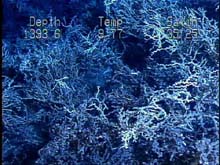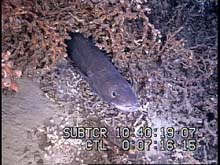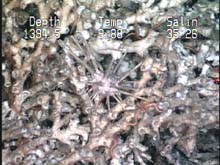
At Lophelia Banks, the coral reef structure is estimated to be about 15,000 yrs old. Lophelia coral grows less than one mm per year, yet the reefs cover hundreds of meters. Click image for larger view.

The conger eel burrows into the reef during the day, coming out to feed at night. In larval form, they are leptocephalous, which means "weak headed." The larvae drift in the water column until they find an appropriate habitat, where they make the change into juveniles. Click image for larger view.

A pencil urchin and red brittle stars rest among live Lophelia coral. Click image for larger view.
North Carolina's Deep Coral Reefs
September 24, 2001
Ken Sulak
Research Fish Biologist
U.S. Geological Survey
Say the words "coral reef" and most people immediately think of warm, clear tropical seas and scuba diving. But deep on the ocean floor, in perpetual cold and darkness, coral reefs also thrive. Without the help of symbiotic algae, deep-sea corals grow very slowly, perhaps less than one mm per year. Over thousands of years, these corals, particularly Lophelia, form extensive reefs in depths of 400 to 4,000 m. Both the familiar tropical reefs and deep-sea reefs serve as habitat for large numbers of fish and invertebrates, providing both shelter and food.
Off Cape Lookout, the rugged North Carolina continental slope gives way to a broad, gently sloping plateau. This is the northern tail of the Blake Plateau, a major topographic feature of the western Atlantic ocean floor. Continuously scoured by the southward-flowing Western Boundary Undercurrent, the plateau is mostly flat and monotonous. Along a series of low ridges parallel to the coastline at 400-450 m depth, however, scientists have discovered a very different and unique deep-water coral habitat.
On these ridges, the stony coral Lophelia prolifera forms massive reefs, supporting a distinct group of fish and invertebrates. The reefs rise as much as 10 m above the substrate, and cover areas hundreds of meters in diameter, forming three-dimensional oases on the otherwise featureless plateau. Similar deep reefs occur in widely separate regions of the world ocean, including areas off Scandanavia, Ireland, and New Zealand. The associated fish and invertebrate fauna has barely been studied, however, primarily because manned submersibles and remotely operated vehicles are the only effective means of observing and sampling these deep reefs.
A Little Studied Habitat
The deep-water reefs occurring off Cape Lookout -- the northernmost such reefs along the U.S. East Coast -- were "accidentally" discovered in the 1960s, during deep drop-camera deployments from the research vessel Eastward. Subsequently rediscovered and precisely located during
acoustic mapping by the U.S. Geological Survey (USGS) in the 1980s, these reefs have become the focus of joint undersea investigations by the USGS and the North Carolina Division of Coastal Management.
During the Islands in the Stream Expedition, scientists will use a submersible to observe, photograph, and collect animals living on the Lophelia reefs, thoroughly documenting, for the first time, the reefs' fauna. A few preliminary dives conducted in 2000 have shown that deep reefs are not populated by species found on shallow Caribbean reefs, but by a unique set of deep-reef species, together with shelf, midwater, and deep-sea fish that take advantage of the reef habitat. Nevertheless, the deep-water, live-bottom coral biotope and its associated fish and invertebrate megafauna remain poorly studied.
Sign up for the Ocean Explorer E-mail Update List.











































